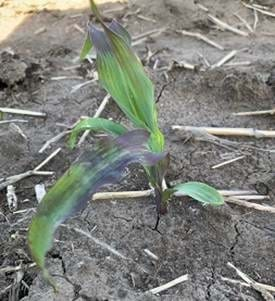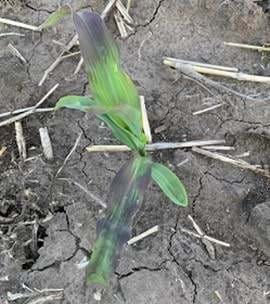Agronomy Update: Corn Color Variations
BY DAIRYLAND SEED AGRONOMY TEAM
There’s a lot happening in the fields this week: finishing planting, wrapping up replant, dealing with some plant diseases, the occasional insect issue (army worm, Asiatic garden beetle, potato leafhopper etc.), first cutting hay is nearly finished, and a lot of post-emergence herbicide is being applied. Side-dressing of corn in many areas is in full swing. So, our notes this week are brief, recognizing that you are busy. We address a couple of “corn color” issues. And we invite you, as always, to let us know if you have specific issues that you’d like us to assist you with. Have a safe week!
Pale Corn
This week’s newsletter addresses several color variations we are experiencing in corn seedlings this week. We are seeing a good deep green to purple to yellow. The yellow and striped corn we are observing this spring could have several causes. The first possibility and perhaps everyone’s knee jerk reaction is nitrogen deficiency. Deficiency doesn’t mean there isn’t enough nitrogen applied, it may just be out of “reach” of the young roots at this time. Most of the yellow and striped corn we have dealt with is on lighter textured soils. So, we could be experiencing some leaching just beyond where the roots are growing. The other scenario is that we just don’t have our side-dress application on at this time, and the plants are growing faster than nitrogen can be supplied.
The second possible reason for yellow corn is the weather has finally become favorable for rapid vegetative growth. The yet-developing permanent root system can’t keep up supplying the nitrogen need of the quick growing plant. As a result, we see the tell-tale signs of N deficiency.
The next reason for yellow striped corn, especially on lighter soils, can be Sulphur deficiency. Sulphur is mobile in the soil much like nitrogen. Heavy rains in the spring can move this nutrient out of contact with the young root system. The cool conditions restricting root growth in May kept the plants from accessing what Sulphur was available.
In most situations, more ideal growing conditions should alleviate the symptoms. In others, completion of side-dress operations, in combination with growing conditions, will snap plants into shape. In many areas, the addition of Sulphur may be warranted. If this the case, a pretty standard practice is about 20 pounds of S.
If you have further questions or concerns feel free to contact your local Dairyland Seed Agronomist.
Update: Purple Corn Leaves
In the last week to ten days I have been getting calls regarding purple colored corn leaves as shown in the photos below.
 |
 |
Purpling of corn leaves can be attributed to a few potential causes:
- Phosphorus deficiency
- Cooler soils
- Soil compaction and/or seed furrow side wall compaction
- Cooler cloudy days followed by warmer and more sunny days
- Combination of these factors
The purpling of the leaves is actually an accumulation of sugars in the leaf tissue. Remember that corn leaves produce sugar by photosynthesis. If the corn plant is growing slowly, those sugars build up in the leaf tissue. This buildup of sugars causes a purplish pigment called anthocyanin to form. Anthocyanin tends to be produced in the surface layer of cells and does not affect the chlorophyll content in the leaf. (As a side note, I tend to think of leaves in the fall turning color especially red or sugar maples with Anthocyanin.) The corn plant is still alive and is actively growing in these instances. With warmer temperatures and sunnier days, it will to continue to grow and green up.
I tend to see this purpling of leaves in headlands or areas of the fields that are cooler or wetter and/or wheel tracks. If large areas of the field have this symptomology, checking planting depth as well as root development on affected plants and comparing them to unaffected plants is suggested. Odds are, affected plants may have been planted in good, but not ideal, planting conditions. Another possibility is that the plant is low on phosphorus (P) which again can be a root or compaction issue. With that being said, P deficiencies tend to show plants with more pale green or yellow striping running in the purple areas.
If you have questions regarding this or other Agronomic topic please feel free to contact your local Dairyland Seed Agronomist.
Corteva Technology Use Agreements
All growers with orders for any Corteva Agriscience brand seed product, regardless of crop or trait (including non-GM products) need to have a signed Corteva Technology Use Agreement in place by September 1. Growers should sign the Corteva Technology Use Agreement electronically at www.agcelerate.com. Signing electronically is preferable, however, paper copies are available at www.traitstewardship.com.
 |
 |
 |
 |
 |
| Brian Weller Western Region 507.456.3034 |
Dan Ritter Central Region 219.863.0583 |
Branden Furseth Northern Region 608.513.4265 |
Rod King Eastern Region 574.596.6721 |
Terry Jones Eastern Region 419.630.3115 |
